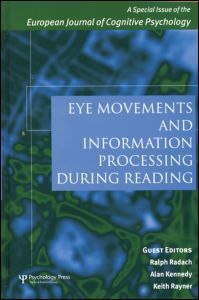R. Radach, A. Kennedy, K. Rayner Preface. R. Radach, A. Kennedy, Theoretical Perspectives on Eye Movements in Reading: Past Controversies, Current Issues and an Agenda for Future Research. R. Radach, A. Inhoff, D. Heller, Orthographic Regularity Gradually Modulates Saccade Amplitudes in Reading. S.J. White, S.P. Liversedge, Orthographic Familiarity Influences Initial Eye Fixation Positions in Reading. D. Drieghe, M. Brysbaert, T. Desmet, C. de Baecke, Word Skipping in Reading: On the Interplay of Linguistic and Visual Factors. J. Hy?Ân?ñ, R. Bertram, Do Frequency Characteristics of Non-Fixated Words Influence the Processing of Fixated Words during Reading? A. Kennedy, W.S. Murray, C. Boissiere, Parafoveal Pragmatics Revisited. F. Vitu, M. Brysbaert, D. Lancelin, A Test of Parafoveal-On-Foveal Effect with Pairs of Orthographically Related Words. J. Pynte, A. Kennedy, S. Ducrot, The Influence of Parafoveal Typographical Errors on Eye Movements in Reading. M.S. Starr, A.W. Inhoff, Attention Allocation to the Right and Left of a Fixated Word: Use of Orthographic Information from Multiple Words during Reading. S.N. Yang, G.W. McConkie, Saccade Generation during Reading: Are Words Necessary? R. Kliegl, E. Grabner, M. Rolfs, R. Engbert, Length, Frequency and Predictability Effects of Words on Eye Movements in Reading. S. Andrews, B. Miller, K. Rayner, Eye Movements and Morphological Segmentation of Compound Words: There is a Mouse in Mousetrap. R.S. Williams, R.K. Morris, Eye Movements, Word Familiarity and Vocabulary Acquisition. K. Rayner, J. Juhasz, Eye Movements in Reading: Old Questions and New Directions.




